This week I wanted to take a look at my most played non-Warhammer miniature war game: Star Wars Legion. Legion allows you to play out ground battles from the titular Star Wars franchise blasting away with Stormtroopers as Darth Vader leads the charge against Luke Skywalker and his plucky band of rebels. Or, if the Clone Wars is more your speed, General Kenobi leading the charge as clones fight to save the republic against Grievous and his droids.
The Core Sets


The core sets come in two flavors. The initial starter covers the Galactic Civil War and contains the Rebel Alliance and the Galactic Empire and the more recent box set covers The Clone Wars and contains the Galactic Republic and Separatist Alliance. The game doesn’t really care about timelines so you can have the Empire vs the Republic. It’s fine, just go with it.
The two core sets are pretty comparable and allow you to play a game right out of the box. You’re going to want to pick up one of these boxes because aside from being a good deal on the models inside, Fantasy Flight Games loves all their proprietary bits and bobs that are necessary to play the game. In this case that includes custom dice, measurement, and movement tools. There aren’t really enough models in the box for two players so heavily consider buying two if you’re splitting with someone. You’ll probably use everything that comes along, and it puts you pretty close to a full list.
Each faction also has a character that is unique to the starter set and to date has not been released outside of it. Imperials get Darth Vader, Rebels get Luke Skywalker, Separatists get General Grievous and Republic gets Obi-Wan Kenobi. This is especially notable if you play a Clone Wars faction; there is only one other character option at this point so you’ll be left with only one option if you choose to go forward without a starter set.
This can make things a little tricky if you can’t find someone who wants to split the box with but the price is quite reasonable for the sheer amount of stuff you get.
The Factions
Reviewing the factions on the whole is a bit difficult because the starter box doesn’t give you the best idea of how they play. The starter boxes contain a commander, 2 corps (basic infantry), and a support unit for each side. The downside to playing with just the starter boxes is you get the vague impression all the factions feel very similar. I personally chose to play the Rebel Alliance because it’s my favorite force from the movies but if you’re more influenced by how a faction plays then this handy guide will give you a vague idea of how they work, once expansions start being added in.
Rebel Alliance
In the core set you get: Luke Skywalker, 2 squads of Rebel Troopers (with optional trooper with a mini gun or Ion cannon) and an AT-RT walker.
The Rebel Alliance is Luke and company from the original trilogy. We don’t see too many ground forces for the Rebels in the original trilogy but it gives you a good idea of how they play. They prefer skirmishes from the shadows as their armor saves are generally pretty terrible, but they’re much better shots than the Imperials. In open warfare they will get absolutely pummeled so it requires you to jump from cover to cover, never leaving them in the open. They’re a bit of a glass cannon faction and have come a long way since launch, where they only seemed to exist to be dunked on by the Empire. Luke Skywalker is one of the best Heroes in the game too, making up for the poor defense of the faction with a guy who can deflect blaster bolts and decimate the enemy with his lightsaber .
Galactic Empire
In the core set you get: Darth Vader, 2 squads of Stormtroopers (each with optional troopers holding a rocket launcher or heavy blaster rifle) and a squad of 2 speeder bikes.
Imps are the polar opposite of the rebels. Terrible shots in general—as the movies portray—but they’re much better armored, have access to better equipment, and have strong Commanders to keep them in line. For a while, Imperials were the dominant faction no contest but they’ve evened out a little bit since then. The Imperials are more of an “elite” faction overall: their stuff is more expensive but synergizes powerfully. It’s easier to jump into the game with Imperials because they’re a much more straightforward faction in terms of crushing the enemy with overwhelming power. Your hero in the starter, Darth Vader the Dark Lord of the Sith himself, is arguably one of the best melee characters in the entire game, but hes very slow so he has to get there first. He’s also unique as the only character who is impossible to make panic, which means his troops near him won’t panic either (I’m sure they’re more terrified of what would happen if they run away from Vader than getting shot at by rebels).
Galactic Republic
In the core set you get: Obi-Wan Kenobi, 2 squads of Phase 1 Clone troopers (with an optional trooper with a mini-gun or long range blaster rifle), and a BARC speeder bike
The Clone Wars factions are new so people are still trying to feel out their “thing” but the Republic looks on paper to be like an even more elite version of the Empire. Their stuff is expensive but has good armor and good shooting. They also coordinate very well; when a unit is shooting or anticipating an attack, that unit may steal a token from an adjacent unit that allows them to aim or dodge. This encourages Clones to work together as a team to share resources and coordinate their attacks against targets. Your included Hero, General Obi-Wan Kenobi, is a defensive Jedi who can take shots for his comrades and deflect them back with his lightsaber.
Separatist Alliance
In the core set you get: General Grievous, 2 squads of B-1 droid troopers (with an optional trooper with either an improved blaster rifle or a rocket launcher) and a squad of 2 Droideka ball droids.
As the closest thing the game has to a “swarm” faction, B-1 battle droids die fast and ignominiously. That’s ok though. You get a lot of them and they aren’t suppressed when shot at and you get a ton of them so they can keep marching on the enemy. They also can synergize with adjacent targets, though in a different way than clones. See, droids are terrible shots, but when they shoot, a nearby ally can also shoot, creating a chain of fire. So while they may not be able to hit anything, the sheer number of shots will eventually clip something by raw statistical odds and also cause them to duck and cover, or even run away in fear! General Grievous is, as you would expect with someone with multiple lightsabers, a blender. He has an advantage fighting against Force Users and since Force Users are often the most powerful Commanders your opponent has, he can exorcise the strong link keeping them together.
Basic Gameplay
The basic gameplay is broken down into 6 rounds and plays like a lot of skirmish wargames you might already be familiar with, with each turn being broken down into distinct phases. The game has a fairly standard “You go, I go” structure where one player activates and completes a units turn, and then their opponent does the same, until everything has had its chance to activate.
Measuring the battlefield
Fantasy Flight loves their proprietary stuff and this is no different. You need these tools to play, and they come in the Core boxes but are also sold separately.
Range Rulers
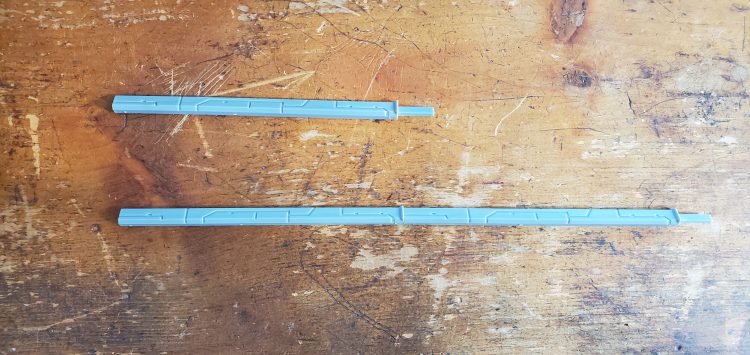
The range rulers aren’t anything fancy. Just plastic bits that you can connect together to determine if something is in range or not. If a weapon is range 2, put 2 sticks together and measure out from the model.
Movement markers
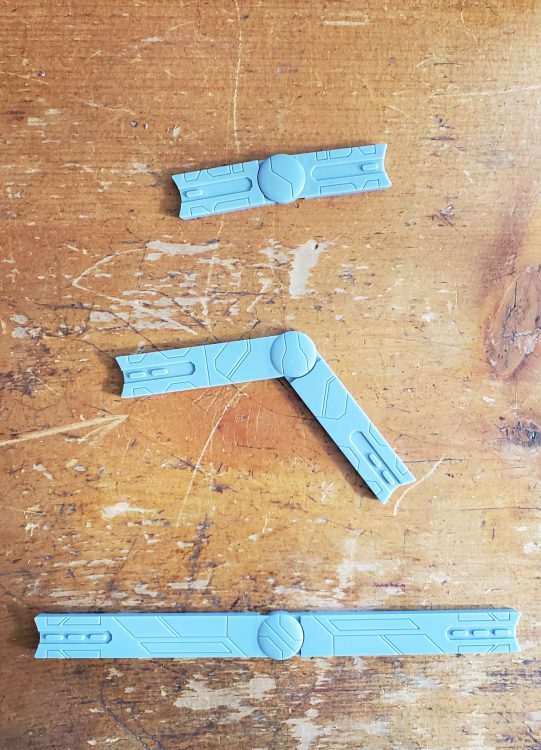
The movement markers help remove some ambiguity from simply measuring from base to base. On a basic infantry model, you can move as freely as you can in most war games, the movement markers are pretty flexible. Vehicles have notched bases however, which you can only move when the movement marker is placed inside this notch. Otherwise, movement is pretty simple: place the marker against the base, adjust it to your desired destination and place the model at the other end. They don’t have to move the full amount if you don’t want to.
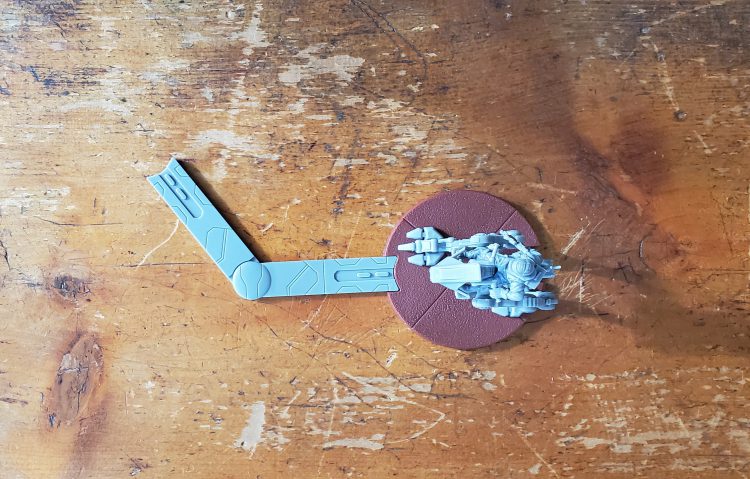
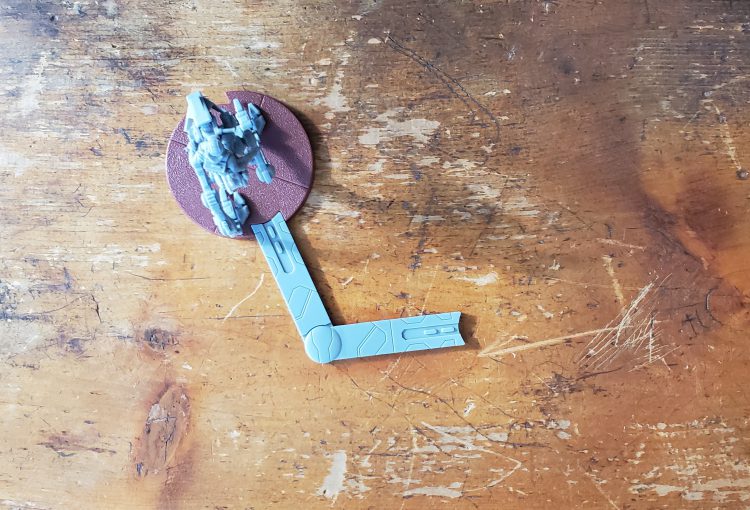
Dice

The game uses proprietary dice which I’m a little iffy on. The core set really doesn’t give you enough to be able to roll your corps shots in one go, so you’ll probably need to buy more if you go further in the game. Which die you used is based on the weapon or defense value listed on the unit card, with d6s used for saving throws and d8s for attacking. White dice = Terrible, Black dice = Mediocre, Red dice = Great. Blanks mean nothing happens, solid symbols mean a success, empty symbols mean a crit (attack that cant be dodged) and a symbol with a line through it is a surge, which might mean a crit or nothing (depending on the card as explained in “Anatomy of a Card”).
Anatomy of a card
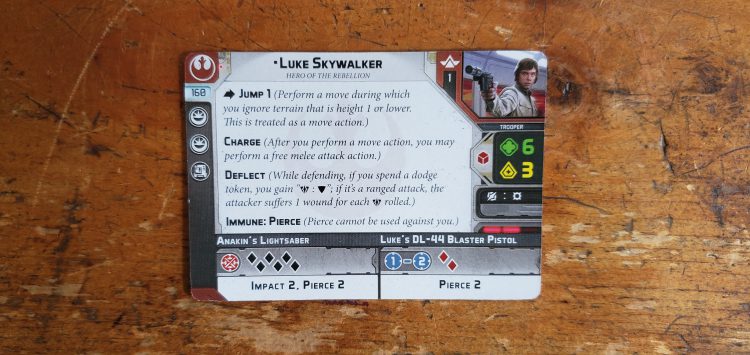
There’s a lot here but it’s not that bad once you recognize it. On the left side is the point value of the card and their upgrade slots. If an upgrade card has the appropriate symbol, they can equip it.
On the upper right (next to the portrait) is their Role. As is of typical most wargames, you’re limited in how many of each role you may take, the number under that is how many models are in a unit by default. The green number below is the health value, if it hits 0 they die. The yellow number is their bravery. If you take suppression tokens equal to it, they become suppressed. If they take double, they flee! The die next to these is the defense die they use when rolling saves, and the symbol below tells you which surge values you can convert on the dice (if any)
On the bottom is the weapons. By default you may use one weapon a turn, and the symbols are straight forward. If we want to use the blaster pistol, we get to roll 2 red dice. The meaning of the abilities is found in the rulebook, in this case Pierce 2 gets to ignore 2 successful saves.
Command Phase
The Command Phase is probably the part of Star Wars Legion that’s most unique in its structure as it attempts to model both the unique powers of the Commanders players have chosen and also to emulate fog of war. Rather than being an omniscient general, able to issue orders to all of your units with pinpoint accuracy on the fly, your commanders have to generally be near their troops to issue orders to them. Even then they can only issue orders to so many units at a time.
Command Cards
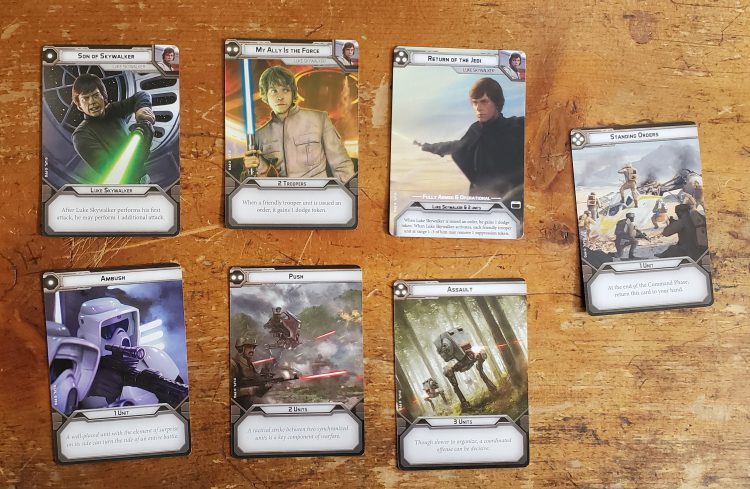
Before the game, players construct a deck of 7 command cards. The structure is always the same: each card has 1-4 pips on it and players need to make a deck consisting of two 1-pip cards, two 2-pip cards, two 3-pip cards and a unique 4-pip card called “standing orders”. In general the more pips a card has the “stronger” it is, and allows the Commander to issue orders to more troops. Once the command card is used up, it’s gone for the rest of the game. Since you have 7 cards, you have one available for each round. The cards come in generic varieties that any commander can use, and ones locked behind specific characters which usually reflect the characters unique talents. These are often named something meme-able (Obi-Wan Kenobi’s “Hello There” or Vader’s “Fear and Dead Men” come to mind). Standing Orders is a frankly terrible card reserved in case you get yourself stuck and are unable to use one of your “real” command cards.
In the actual game, what this translates to is each round both players draw a command card and reveal them to each other at the same time. They “issue orders”, which means to assign tokens (Containing the symbol of the character’s “Role”) next to units within 1-3 of the commander issuing the Command Card on the included range ruler and put the rest of the role tokens face down in a random order, or placed in an opaque container or bag. The meaning of these will come up in the activation phase.
The twist now is that whichever player had a command card with the fewest pips gets to go first! In the case of a tie, players roll off but this adds a level of strategy to the game. Do you risk the (generally more powerful) higher pip card knowing you will probably go second, or get in a quick strike on the opponent, sacrificing your army’s cohesion for a turn.
Activation Phase
Whichever player’s turn it is, they may now choose a unit. Remember how in the command phase we put down tokens next to units and threw the rest face down? This is where the game’s fog of war mechanic comes in. You can either activate one of units with a token you placed face down, or draw from your random stack of remaining tokens. For example, if you draw a Corps token, you can choose any corps unit that does not already have a token next to it. In essence if you choose to go first you’re sacrificing direct control over the order of activation of your troops, as your commander is more focused on the attack. A key piece of the games strategy is keeping army cohesion together, and working around the semi-randomness of activation.
Either way, once you activate a unit you have a choice of actions. Each unit can perform two actions under default circumstances, though if they are suppressed from being shot at a lot, it reduces their action to one. Possibly none, if they’re completely panicked and are running for their life. They can perform any action twice if they wish, except for attacking.
- Move- Move the unit, using the movement tool, the distance it says on the card. Quick note that I really like how movement is handled in the game. Rather than measure every model’s movement, you just have to move the commander. Once they’re in place you can move the rest of the unit in coherence (Range 1 on the range ruler). This drastically cuts down on game time wasted faffing about with movement, as the game abstracts movement substantially enough to avoid quibbling over whether each model moved correctly.
- Attack- Hit the thing. Unlike a lot of games the game isn’t broken down into shooting and melee phases. You can just pick a weapon and attack with it, range permitting of course. If you hit the unit makes an armor roll and if they fail, a model takes a wound. They also take a suppression token, if they get a number equal to their courage value, they become suppressed and only get one action. Double it or more and they flee! Most troops have poor bravery but can “borrow” a commander who is within Range 3’s. Commanders usually have better bravery.
- Aim – Give yourself an Aim token, this lets you reroll 2 dice when rolling to hit a target.
- Dodge – Give yourself a dodge token, this lets you ignore 1 non-critical hit.
- Overwatch – If you did not shoot you can have a unit go on overwatch instead, and it can peg a target that stops its movement within its shooting range. Only once though.
That’s it really. The game gets drastically more complicated once you factor in all the different tokens and abilities each card has but this is just to get started. Each unit has access to a bunch of different equipment which can give them more abilities and more ways to respond to the opponent’s actions. These include things like grenades, suppression weapons, Force Powers and so on.
Once a unit is finished its activation, you flip the token next to them face down (To represent that they have gone and cannot activate again) and your opponent follows the same procedure. Repeat until every unit has had a chance to act.
End Phase
Standard clean up phase. Get rid of all your tokens (and 1 suppression token) and prepare for the next round. Repeat until 6 turns have passed or one side is wiped out.
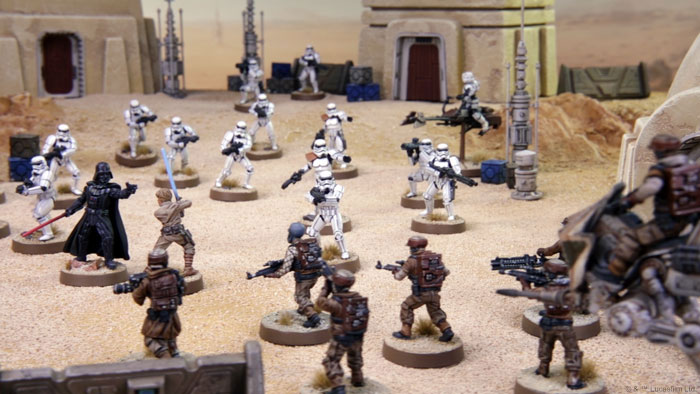
Expansions
As mentioned above the Core Set is pretty barren in terms of teaching you the extent of abilities your faction gets, as each army is basically given the same units. The expansions are varied and too numerous to list off but they’re slowly hitting all the major stuff you’d expect. Rebels get access to characters like Princess Leia and Han Solo, while Imperials get Palapatine and Boba Fett. Republic and Seperatists are still early so for right now they get access to Captain Rex and Count Dooku respectively. Units include familiar faces like the soldiers and scout troopers from Hoth, to vehicles like snowspeeders and AT-STs.
The game falls rather cleanly under the Disney license but they’re grabbing units from a pretty wide variety of sources. The first 6 movies of course, but also from Rogue One, the Clone Wars and Rebels cartoons. Recently, the Inferno Squad from the newer EA Battlefront game was announced for Imperials. So Fantasy Flight seems to be able to draw from a pretty deep well and if your favorite character or unit isn’t already in the game it probably will be. [Editor: Glad to see they didn’t wait forever to bring in Clone Wars stuff, like they did with X-Wing]
The game does a lot of “mirror” units. For example both Rebels and Imperials have access to a commando squad of snipers which seem almost the same on paper, and Seperatists and Republic have their own snipers coming soon as well. This helps keep the balance more or less intact and while on paper it may reinforce the idea that there’s no difference between the factions, the interplay between units can drastically change how they play on the field. Each faction has its own models that aren’t replicated across factions either, so the diversity does remain intact.
The Good
- Excellent turn system: The activation system is one of the best I’ve played in a wargame. The alternating activation and command card priority mean you have a lot of control over how your turn is going to play out. It’s simple to learn but difficult to master. If you know a lot about your opponent’s army you can often guess what card they might use and play something that will allow you to go first.
- No core book or codexes to mess with: The box doesn’t come with a core rulebook, but that’s because the core rules are published in a pdf and often updated. The cards come with the units themselves so you don’t need another rulebook to know what your models do.
- Cards help the learning curve: Having cards in front of you reminds you what each card does and you don’t need to flip through an unwieldy codex to check. It also lets you remember what gear you have so you never forget. FFG has received criticism in the past for making upgrade cards hard to obtain, requiring you to buy units you won’t use just to get the cards. Thankfully they created a cheap upgrade pack that includes most generic upgrade cards off the bat.
- Faction balance is pretty solid: You can play a game and have a good time with whichever faction you like. While Clone Wars factions might struggle for now, they have time to catch up. Galactic Civil War factions are pretty balanced, after a few months of Imperial supremacy.
The Bad
- Lots of terms to remember: The cards can go heavy on unique terms. Similar to a Magic the Gathering card when a new ability is introduced, some cards have descriptions, some don’t. It can be wildly inconsistent and it’s a lot of terms to remember. It can be inconsistent which doesn’t help the learning curve.
- Model quality is so-so: These aren’t GW models and there’s a lot of flash on them. Lightsabers are especially bad about bending on you and might require some hot water to fix. Still, the detail is pretty solid and there’s been a strong improvement since launch in build quality.
- Lack of Generic Characters: This is going to vary from “not an issue” to a huge pet peeve depending on who you are. Some people don’t like that every battle in a wargame has to involve a named character so if that’s a problem for you look elsewhere. Imperials and Rebels get a generic general option which is ok but probably not going to be replacing named characters entirely. They exist more as a budget option when running low on points. Of course, you could always make your own model and run them as “counts as” but that may not be sufficient for some who want their own original characters to have their own identities.
Conclusion
Star Wars Legion is one of my favorite war games to come out in years. It has some very clever systems and once you understand how everything goes together its a very fast paced game. The initial hurdle can be difficult, the game throws a lot of terminology at you fast and it’s similar enough to other wargames but just different in a way that can throw you off in the early learning phase. Once you get past it, it incentives fast, aggressive play and clever use of terrain. I would highly recommend it in general but especially to Star Wars fans. Fantasy Flight Games has been supporting the competitive scene and it’s continued to grow substantially, especially since the Clone Wars expanded the game past the initial 2 factions.


